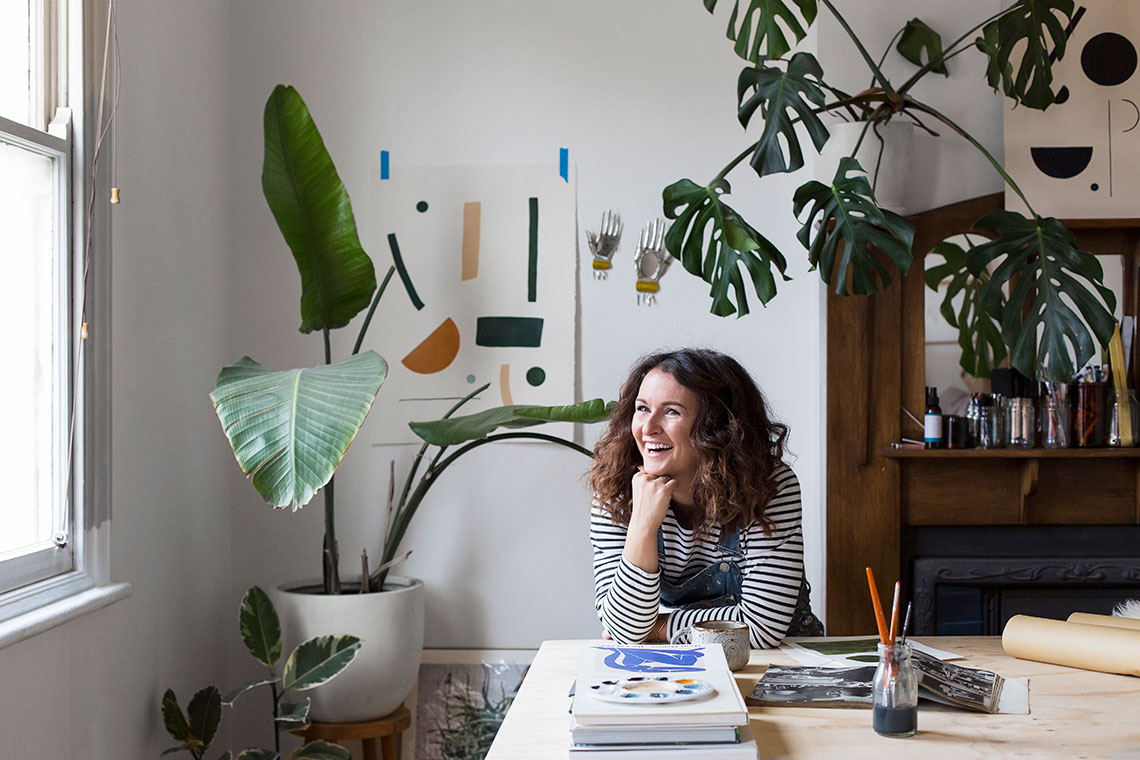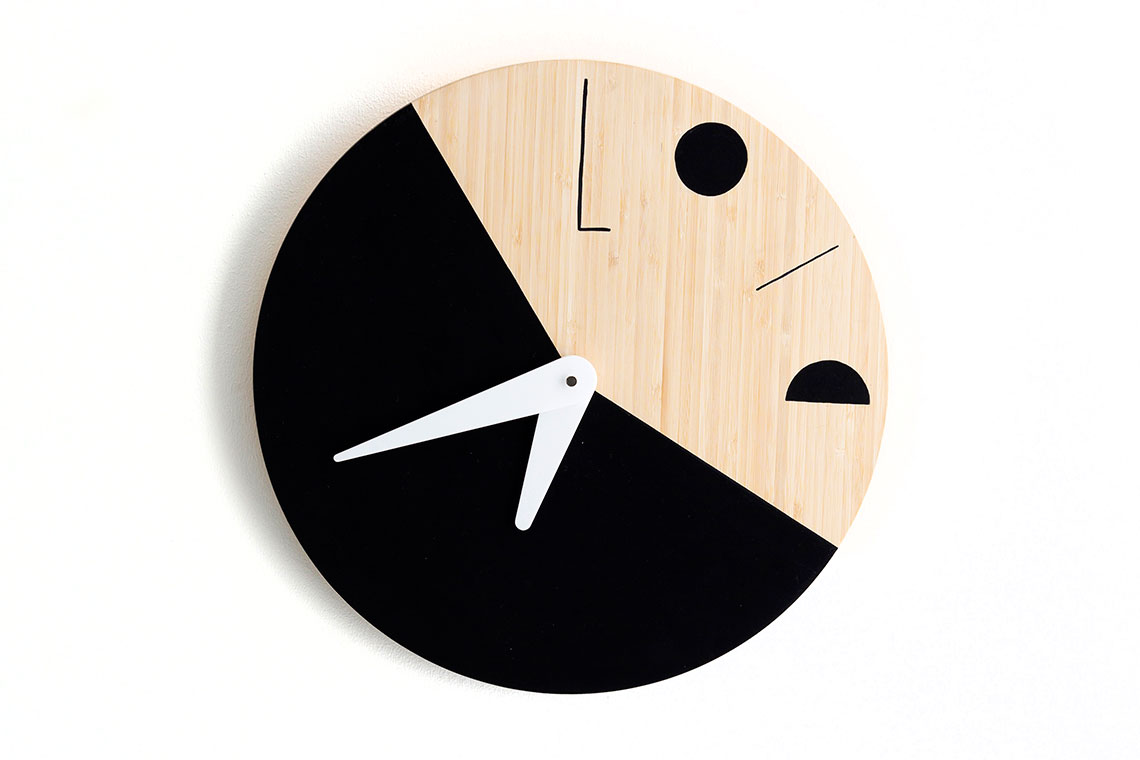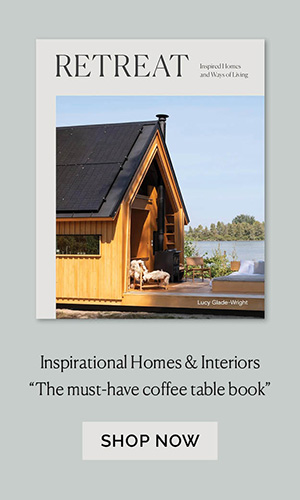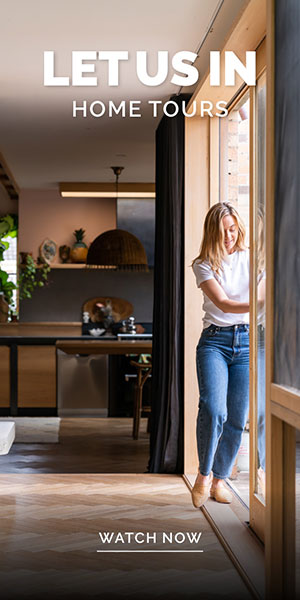Bobby Clark is a tornado – she sweeps you off your feet and takes you with her at a million miles an hour. She loves life, she is candid and blunt and to top it all off she has an irresistible Scottish accent that keeps you hooked on every word she says. I first met Bobby a couple of years ago in the Pop & Scott workshop. Her talents were clear, not only as a painter and photographer but her energy and gregarious nature made her friends with many.
Bobby has had an interesting creative path in life. From her background in fashion and textile design she has experimented with many different techniques and undergone vastly different jobs. Always encouraged to draw by her Gran, it’s clear that Bobby is grateful of her creative upbringing and now sights books, travels and the great masters is some of her biggest influencers. Bobby’s laughs at the irony of her minimalist painting style, given that she never quite understood minimalist art when she was younger. This candor is what I love most about Bobby. She is intrinsically creative which she embraces with humour and authenticity.
Bobby’s clock is available via online auction. To bid, click here.
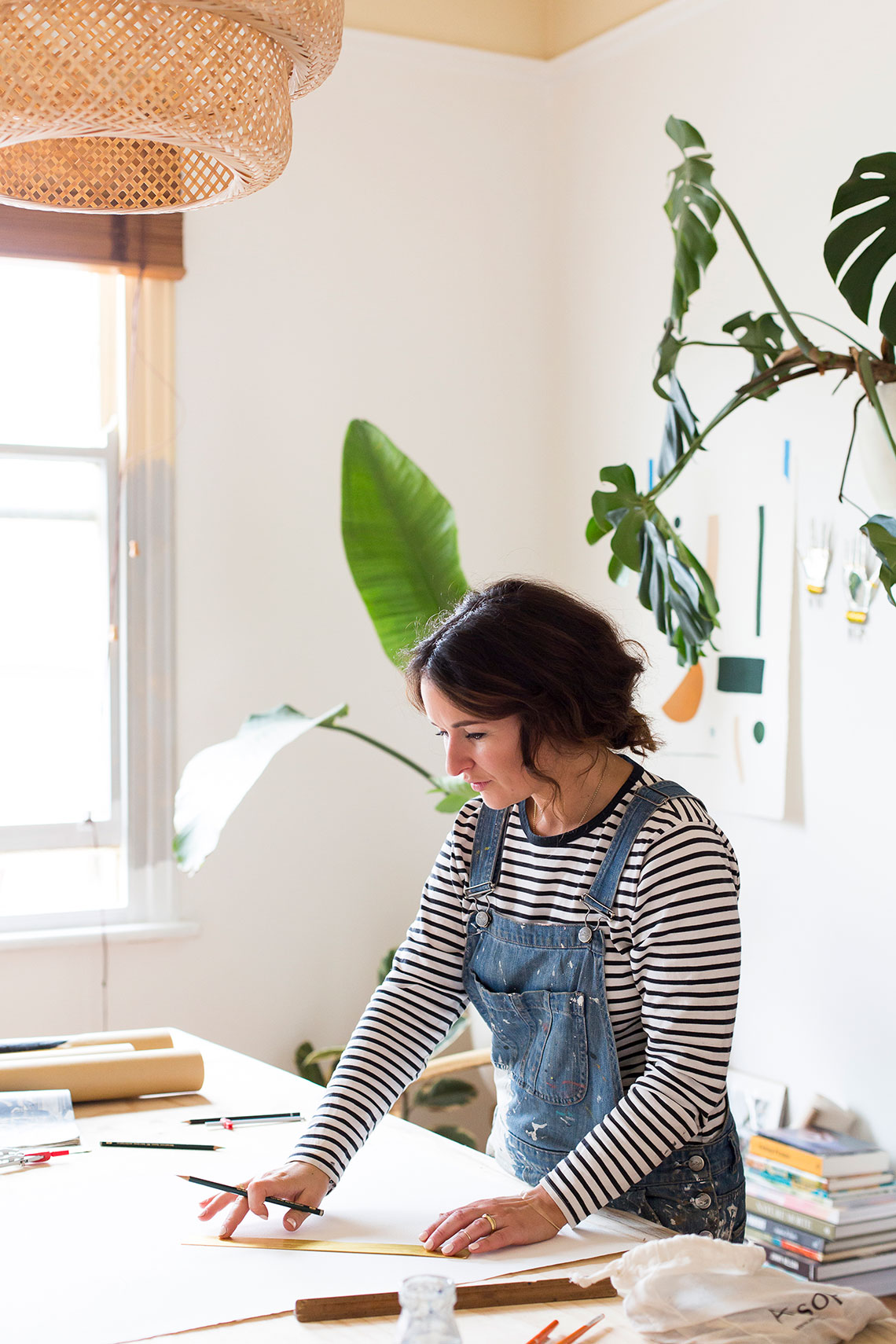
Can you describe the feeling that you get when you’re painting?
The feeling I get when I’m painting is… well I don’t really get any. That’s the reason why I love it. I just completely switch off. I come in here, close the door, put the music on and I think about nothing. It’s the one thing in life that I don’t plan. I don’t stress. I just do it, and then in the end, I’m like, “Uh, I like it, nah, I hate it,” whatever. It’s my favourite thing because it just switches me off.
When did you realise you were creative?
I think it’s always been there. I’ve always been creative. Ever since I was a wee girl, I would draw on phone books, everything. I actually used to draw portraits of myself and put a little line in for my cleavage when I was four. My family’s all creative as well. We were encouraged to just draw and paint. We loved being outdoors. My gran would set up still life’s for us in the house just to keep us quiet. “Here’s an apple and an orange. Go and paint.”
I’ve always known that school was never for me. I loved art. That was my favorite class. I liked English, but the other subjects would just bore me to tears, and I’d count down till I got to art, so I always knew that I was never going to be in some office nine to five job, or doing anything with numbers. It was always going to be something with my hands.
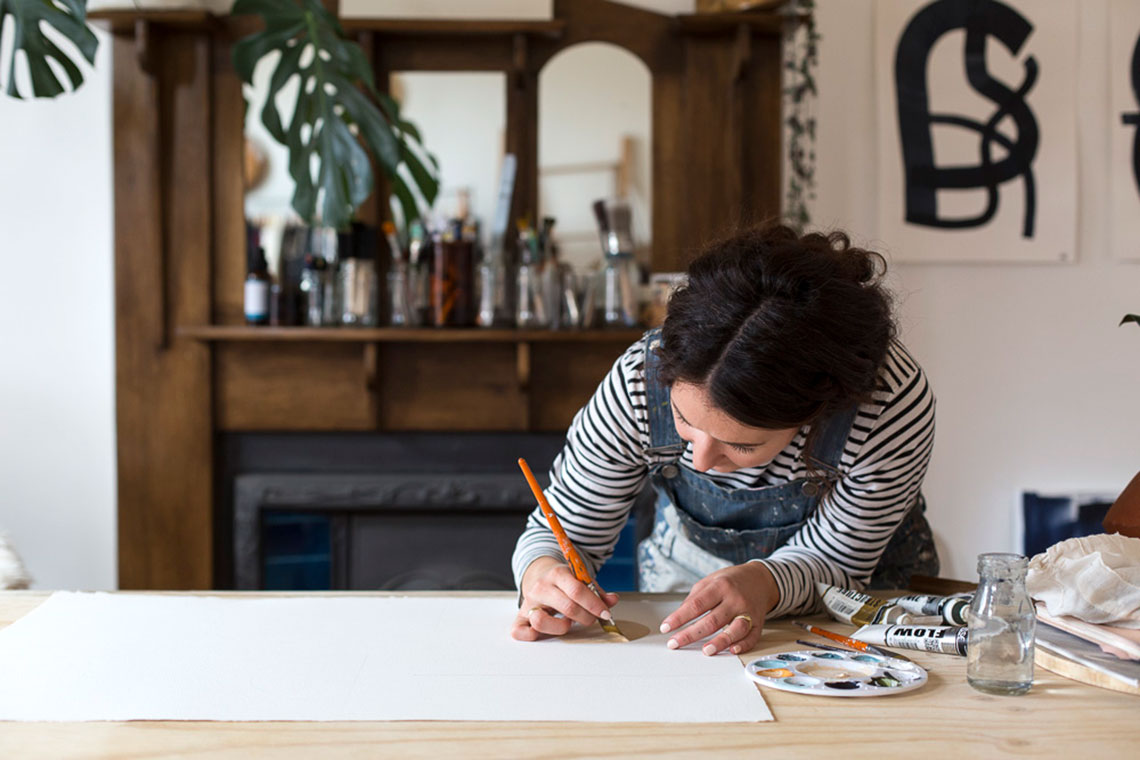
Your career has included fashion, textiles and photography, but now your focus is back towards painting. How important was that progression and experimentation for you?
I mean, it’s been such a long and ridiculous road to get me here. I felt only in the past year that things have clicked. It’s made me really realise, I think I was fighting a lot of stuff. Like I should be doing this, I should be doing that. I don’t regret anything I’ve done, because everything leads you where you are now, but I sometimes think I have wasted time, like I should have studied photography, then I’d know the basics and the proper things I should know. I should have done a proper art degree, and then I would have all this time that I’m trying to fight to have now.
That time would’ve been mine, and I could’ve honed my skills, but it wasn’t the way it was supposed to be. I think it’s helped me in other aspects. I can do plenty of other jobs. I’ve got the business side. I’ve done garment construction. I’ve done all these weird things, like I know loads about fabrics. I’ve printed on all textiles. I’ve made scarves. It’s only adding the experiences and skill sets you have, so it’s obviously the path that I was meant to go on.
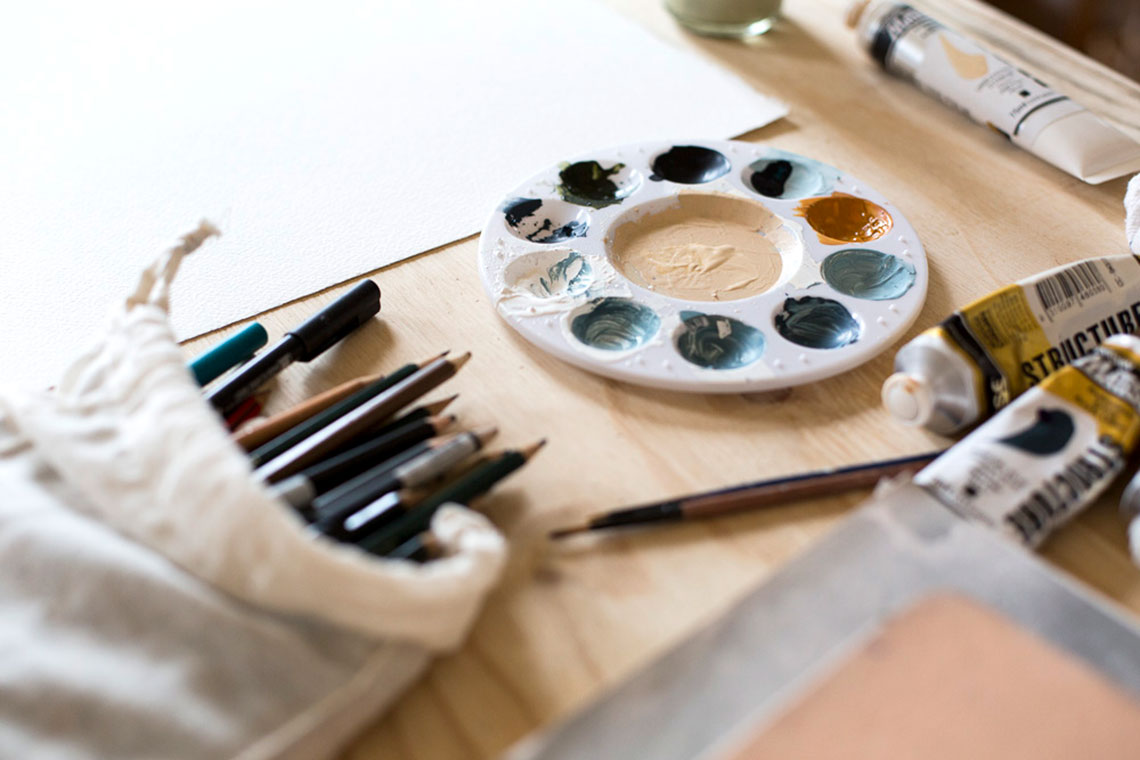
Where do you draw inspiration from?
Mainly books. I love books. It’s easy. They’re everywhere. I really love art books. When I was in art school, we were encouraged to start a project either through photography or research, and the libraries that we had there were incredible. I love old books and finding vintage books.
I really try and stay away from social media. Although it’s the best tool in the world, I feel that it starts to manipulate what you do. You have a picture of something that you’re going to do before you’ve even started doing it. So I’ve tried when I’m painting, not to look at social media and compare what I’m doing with what other people are doing.
I love Picasso. Reading about him, reading about his life actually more than his art. I love looking at his art, but his life, he had this amazing life and all these women. He was a bit of a floozy. When I’m reading about him, it makes me want to go and do something.
I wish I could travel more. Hopefully in the next two years, I’ll have been in Morocco and Cuba, and all these amazing places. Because I think when you travel you come back so inspired from your holidays. Just seeing the colours, the buildings, the streets. Things like that really inspire me.
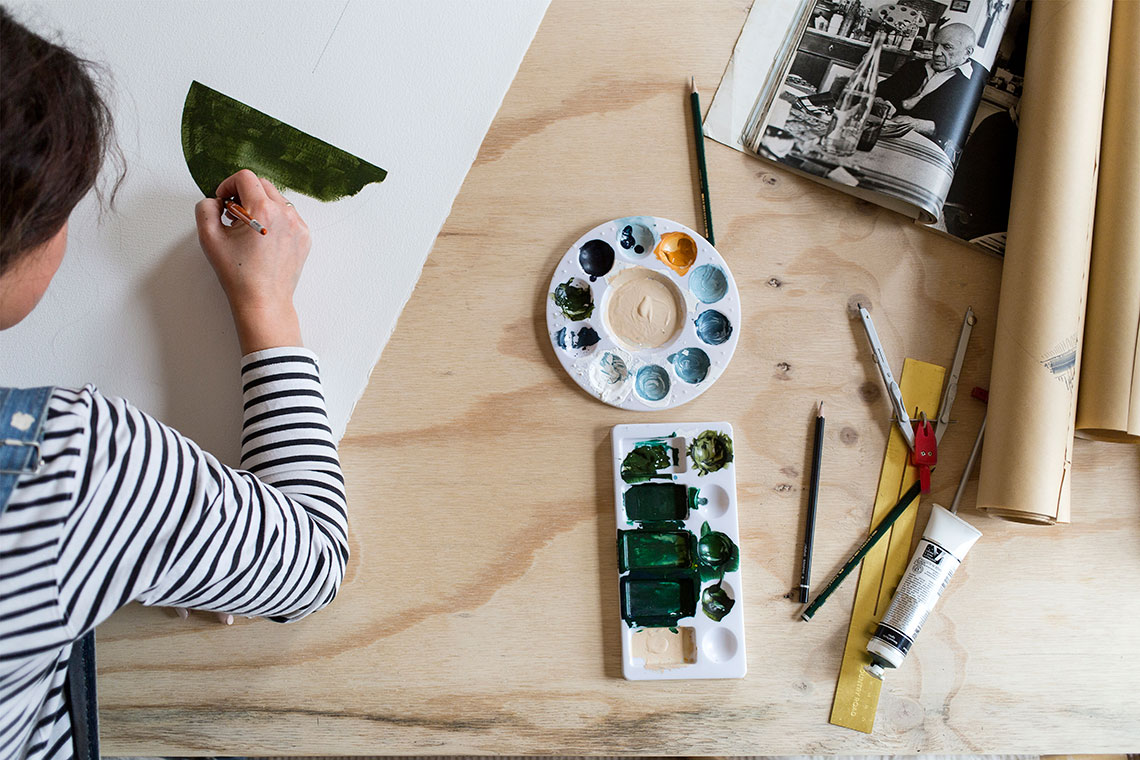
How do you start a new artwork?
I start paintings probably the worst way that anyone could start a painting. I just start. I don’t plan. It’s something that I’ve tried and I’m trying to do, maybe start keeping a diary. But it’s something that’s more about feeling for me. I come in and I switch off, and I don’t really use my mind at all. I just go with the flow and go with my colours and shapes. I usually just start by placing a few different images on a piece of paper and working out the balance as I go.
I first started off using plates which was hilarious. Bruce Rowe of Anchor Ceramics used to come out as I actually used to use his plates a lot back in the day. I’d come out and get dinner plates, and bowls, and side plates, and sticks and stuff. That’s how I would build a composition. I’d put the plates down with a ruler, and then I would build it from there.
Bruce came in one day and he is like, “Have you ever heard of a compass and a ruler?” So I stopped using plates after that, but I still guess my way through it. It seems to be working and I’ve not run out of ideas yet, but you never know.
How would you describe your work?
It’s minimal, balanced and abstract to a point. It’s so funny, because when I was younger, I didn’t understand abstract art at all. I was like, what is that? Anybody can do that. It’s like a shape on a piece of paper. And now I’m ‘the shape on a piece of paper’ artist which is hilarious.
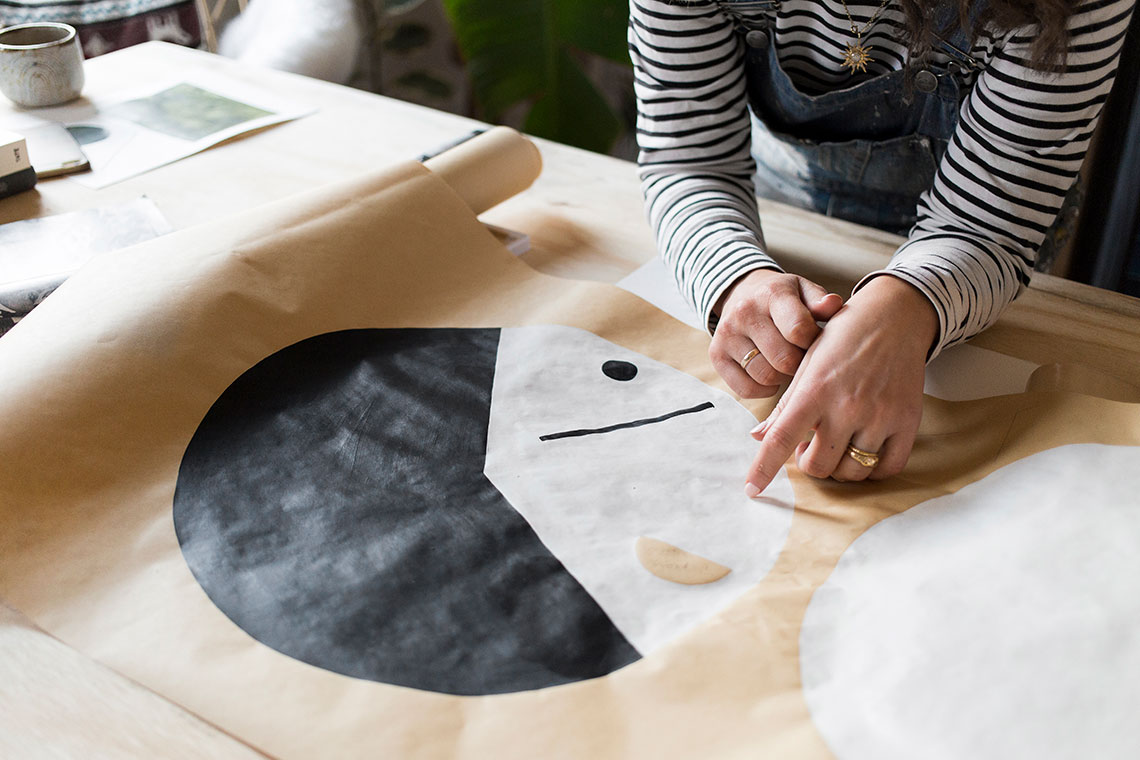
Who has been a major influence in your artwork?
My major influence is definitely my grandmother, Joan Barber. She, from a really young age, really honed in me how to paint. She would sit with me for hours teaching me how to draw an apple or a flower. She always had beautiful plants, really unusual plants in her house, and she would always encourage me to sit down and draw and make a mess. It was never an issue. She would be like, “Get the paints out.” We would have papers everywhere and it was just so encouraging.
I really look up to my gran. She had such a hard life and she worked so hard. She never complained and always encouraged us. We were never ever told not to do anything if we were playing. I just always look up to her. She made me want to be an artist. I feel like if she was still here today, she would be really proud.
My husband as well, Steven. He’s really creative and we balance each other out. If I’m going through a creative block, he pulls me through. He’s like, “Oh, come see this. I’ve seen this. I know you’ll really like it,” and makes me watch things. Same with him. If he’s going through a difficult patch, we always stock up. We have inspiration in each other that pushes along.
My family are all creative. My aunt, my cousin has an amazing career in TV. I’m pretty lucky. They’re all pretty inspiring. They’ve got amazing things going on in their life.
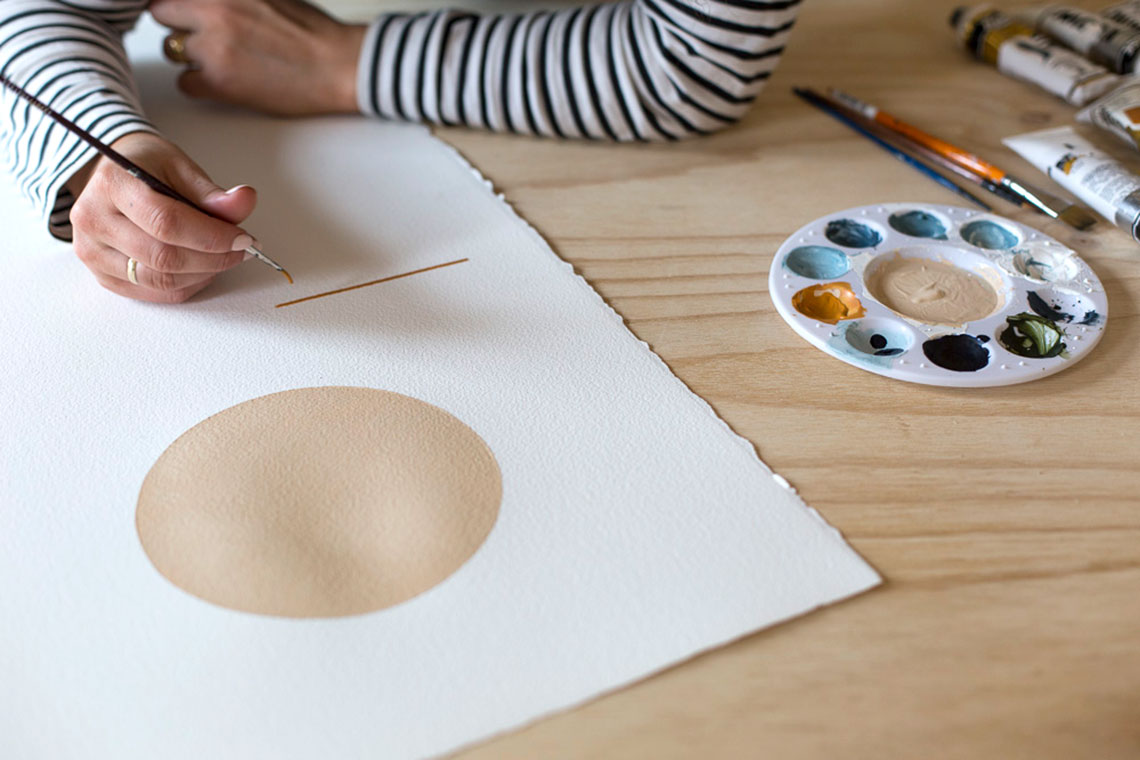
What is the most important part of your creative process?
The most important part of my creative process is probably the set up before I start painting. I have to work in a clean space. I cannot have things out of place. I’m a creature of habit, so it always starts in the same way. I usually always put on classical music. I can’t listen to anything else. It’s like if I’m singing along to something, I’m not paying attention.
The starting process before I even pick up a brush, it’s ritualistic. I need to know where my things are, that my brushes are clean, that my paint is all in the same spot and then I can start. If something’s out of place, it’s game over.
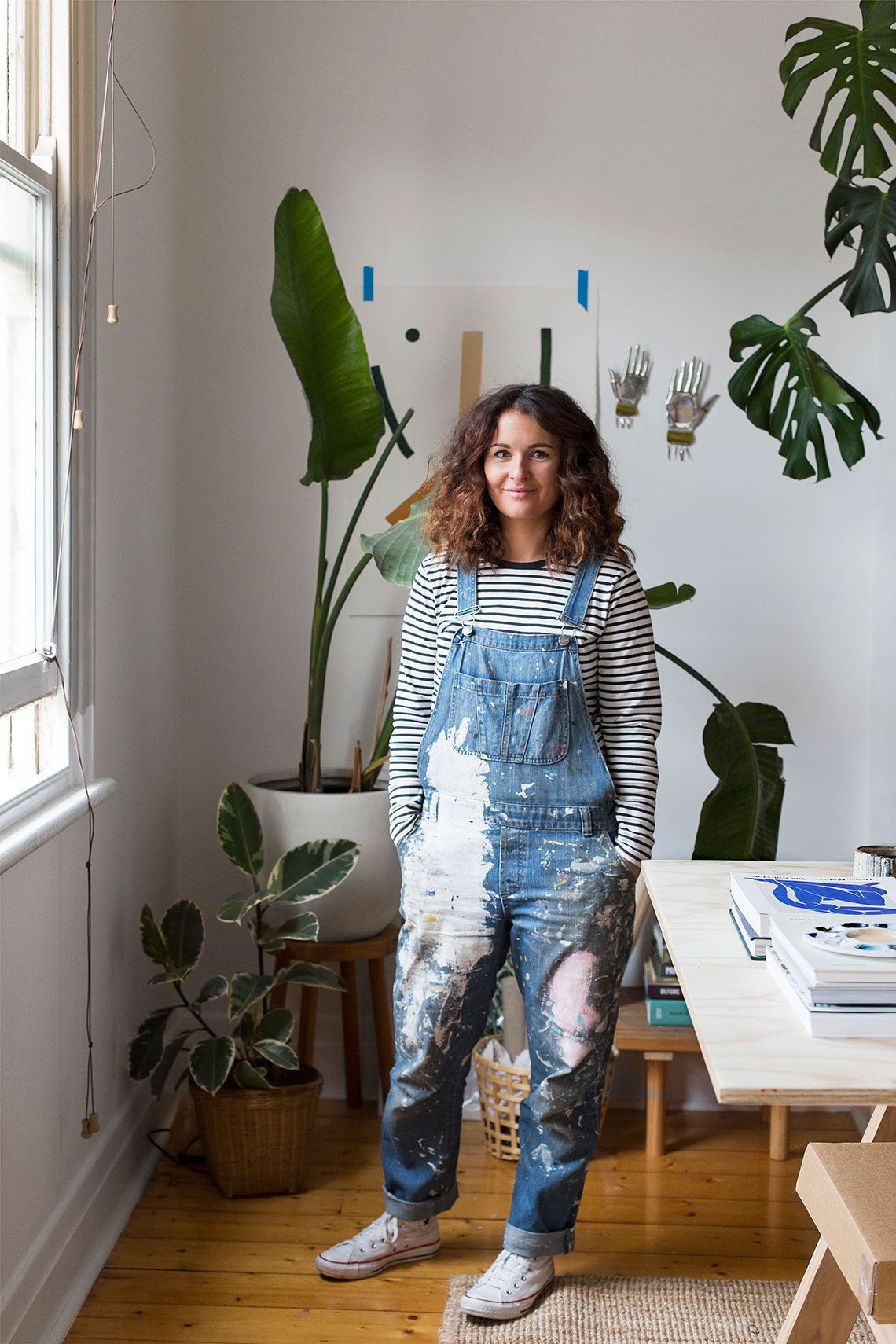
How do you know when you’ve finished a piece?
I know when I’ve finished a painting just because I know. It’s hard to describe. You know when to stop. Sometimes I’ve worked too far and do three things to many which is frustrating. You get a feeling when the balance is right. Because I work on paper I can’t paint over it and start again, so I’m quite strict on myself.
What happens to the piece of paper if you go too far?
They’re in the back of the cupboard that’s sitting in my hallway. I actually don’t throw things out. Steven always warns me never to throw things out because you never know. You could hate something right now and think it’s a mistake, but six months down the line I might like it. The things that I dislike, or hate, or think I failed on, when I look back, I’m like, “Actually, that was the most interesting thing I’ve done.” But if I do properly hate the painting, it just gets turned over and I use the other side, or it gets put in the fire.
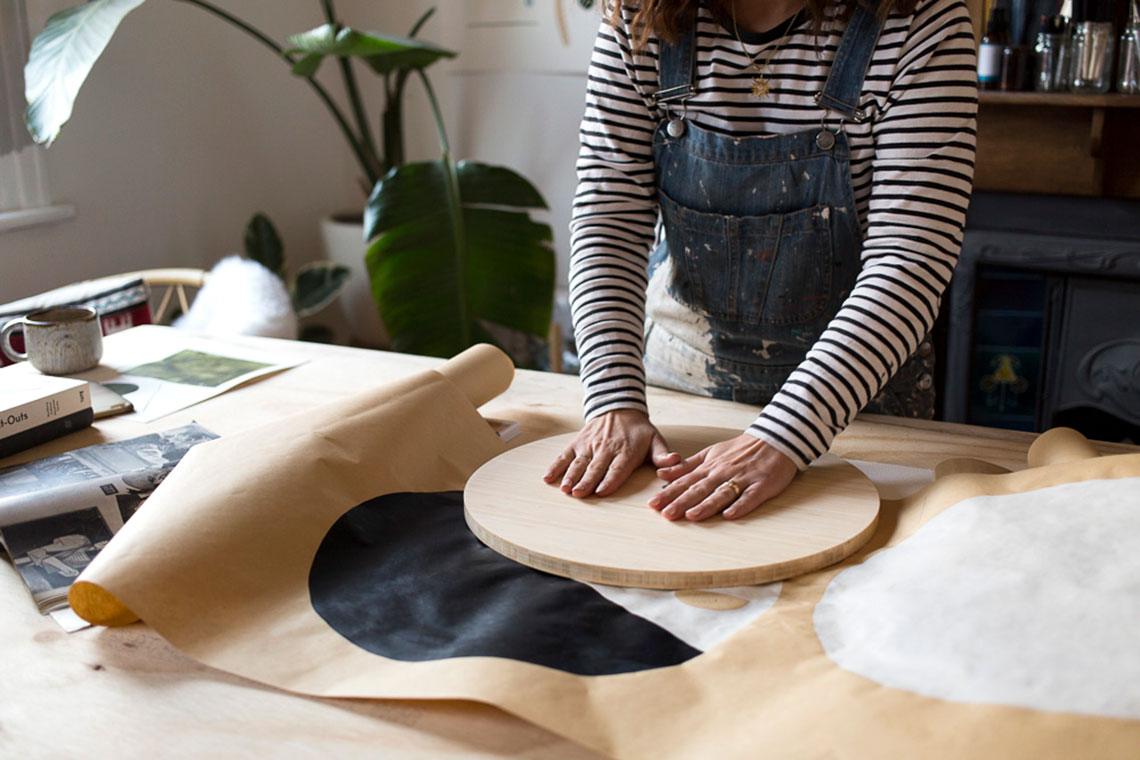
What is something that not many people know about you?
I’m from a tiny town in Scotland called Greenock. It’s tiny and it’s boring and it’s by the sea. I live next to sheep, a lot of sheep. Oh and I hate coriander. That’s about as interesting as I get.
What is the inspiration behind your clock?
The clock, it’s hard because I’m working with a circle. I think because it’s a final, I know it’s going to be for something and someone’s going to want it, which makes me scared. I want to have markings of where the times would be. That’s an idea I’m playing around with, how to make it a beautiful design but also a functional clock as well.
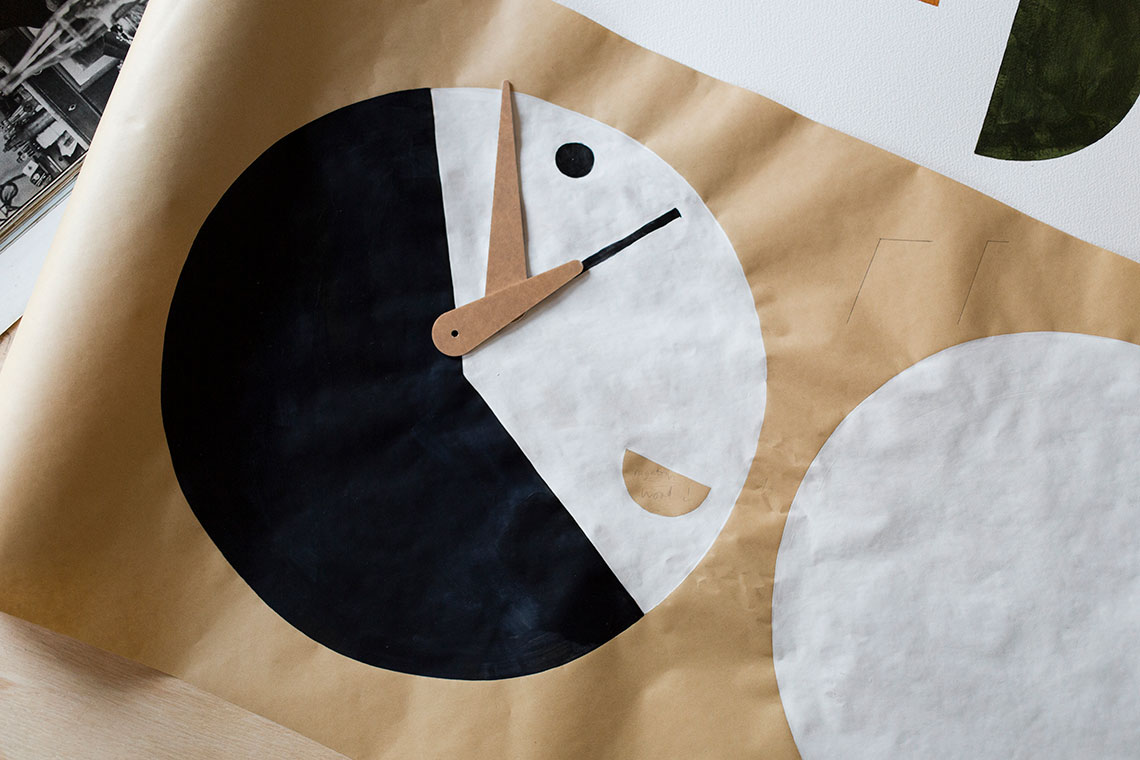
What type of person do you think will be drawn to your clock?
Someone that likes Scottish people? No, I’m kidding. It’s someone that has quite a minimalist approach to design, someone who has a lot of white in their house, someone to keep it quite neutral. I want it to be able to fit in a few different places. They’re just going to be into nice, simple shapes with good use of colour. Not too wacky. A practical person.
What do you love most about creating?
That it all comes from my head. There’s not many jobs in the world … Well, there is, but not ones I could get, that allow you to be totally free in your decisions and what you make. You’re setting your own brief which is also scary as well as amazing. You can decide what you want to do that day. You can decide what you want to paint, what colours you want to use, how you feel, and if you’re having a shit day, you can just go and have a coffee, and go for a wander, and choose not to work. I think that’s the most beautiful thing about being creative.
Bobby Clark’s Clock for the Hunting Collective 2016.
Bobby’s clock is made with acrylic paint. Bobby’s clock is available via online auction. To bid, click here. Bobby Clark is a minimalist artist based in Melbourne, Victoria. Intrinsically creative she embraces both her artwork and life with humour and authenticity.
All photography by Martina Gemmola for Hunting for George



